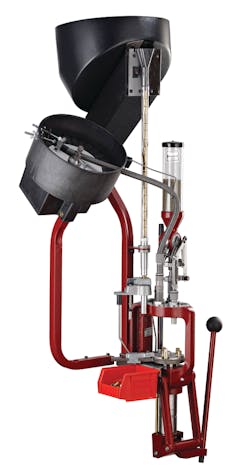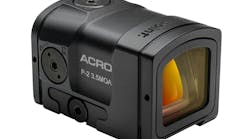Reload to trian
Lindsey looks to Hornady's Lock-N-Load AP Press in an ammo crunch
A few years ago, most police agencies would not have considered reloading metallic cartridges as a means of providing practice ammunition. However, one does not have to look hard to find news of ammunition shortages nationwide. A lot of political posturing and finger-pointing has been exercised over the lack of ammunition. Regardless of the source of the shortage, my informal poll of law enforcement agencies indicates that many agencies have reduced their training allotment to bare-bones. They simply don’t have the inventory for adequate practice.
Adequate practice is not the number of rounds allotted by policy for training and qualification—that’s the minimum. Adequate practice means that officers get enough trigger–time for formal and informal practice on a regular basis.
For some reason, reloading in law-enforcement agencies has never been considered risk management friendly, even though some departments have been reloading for years. If an agency’s policy impacts its efficacy (Oklahoma City v. Tuttle, 471 U.S. 808 (1985)), or provides inadequate training (City of Canton, Ohio v. Harris, 489 U.S. 378 (1989)), they’re wrong.
Considering the statistical increase in danger for law-enforcement officers nationwide, our officers should be shooting more, not less. The way to do it is to pick up fired brass on the range and scrounge for bullets, primers and powder. Yes, these things are scarce, but not impossible to acquire if one pays attention to the market.
Law enforcement officers who reload to augment their training know that reloaded cartridges can be loaded to mimic the performance of duty cartridge counterparts. Remember, reloaded stuff is for practice only.
For this column I tested Hornady’s Lock-N-Load Ammo Plant Loader, hereafter called (appropriately) the Lock-N-Load AP. It turned out to be a solid performer, cranking out plenty of practice ammunition for serious training.
The Lock-N-Load AP Press is a 5-station, auto indexing, progressive press. It can be purchased with an automatic bullet feeder and automatic brass feeder. The model I tested did not have these two features; I found that any user can get into a cadence where completed cartridges fly into the bin using the patented EZject system.
The Lock-N-Load AP Press is manufactured with great attention to detail. It doesn’t have spurious casting or machining marks, or unfinished surfaces. It is designed and manufactured the way law enforcement users like to have their equipment: over-engineered. Sometimes this type of treatment just makes products look nice. The Lock-N-Load AP Press, with its huge ram and frame, also has a significant amount of operating leverage and natural smoothness in its operation.
The smoothness and leverage could be to the disadvantage of this press. For example, this press seats primers on the downstroke, where the user is pressing the lever forward. Although it has plenty of primer “feel”, where the user can literally feel the primer enter the cup, it’s several times the strength of a hand-priming tool. Since I’m a 223 user, I had to sort my brass carefully. Military style brass, of which I have several thousand, has crimped primers. Without that “feel” (and good sorting), the leverage of the primer seating punch could easily force a primer into crimped brass.
The Lock-N-Load AP Press is slightly less expensive than competitive models. It is beefier and a little more versatile than its competition. Since I had other products for which to compare this product, I found it only moderate in the speed in which one can reload—honestly, several other presses can flat outrun it, given the same user with the same experience. However, it is definitely on the top end of precision, and accuracy wins here. In other words, quality rules. Powder measuring, primer seating and bullet seating are more predictable on this product then many others I have tested. In fact, the Lock-N-Load AP Press has the type of consistency that one can get from single-stage (one at a time) reloading, at a much faster rate.
Each station moves half a stage on the upstroke and half a stage on the down stroke, making for ultra-smooth function. This process is much smoother than presses that do all their indexing on the down stroke.
The strongest suit for the Lock-N-Load Ammo Plant is its versatility. It is capable of almost any caliber, using any standard dies, with almost any powder and bullet combination. I tried it with a die set that was several decades old and I used it to reload some wildcat (non conventional) cartridges.
Hornady uses a heavy gauge rod that surrounds the primer tube. This is an important safety feature: when primers are stacked, accidental detonation of a single primer risks detonating all of them. Some manufacturers use a primer feeding system that feeds from a tray, not a vertical tube. This is generally safer, but is not as smooth, and looks like an appliance attached to the press.
Primer detonation is a statistically unlikely event, but without the safety features, it could be catastrophic. The Hornady system is engineered to deflect all of the dangerous stuff away from the user. Still, it is important to remember that every reloading operation requires safety glasses.
The primer tube holds an entire box of primers and it can be filled without removing it from the press. I have to admit; I learned how to operate it the wrong way. That is, I assembled it incorrectly, which caused me to spill primers on the floor. Don’t blame Hornady for this…I didn’t read the directions. Considering the fact that several resellers of this product also have instructional videos, I have no excuse for my folly.
Besides the smooth priming operation, the Lock-N-Load AP Press uses case actuated powder dispensing. Not only is this the safest way to dispense powder, the Lock-N-Load AP Press uses a brilliantly engineered linkage system and a micrometer measuring system.
Many progressive press products use a powder bushing system to measure powder. That is, reloading powder is dispensed into a chamber of a specific volume. The user selects a bushing that is designed to throw a certain volume of powder, selected from a table that lists power brands and their corresponding weights, related to the powder bushing.
The Lock-N-Load AP Press doesn’t use a bushing. Rather, Hornady uses a standard micrometer powder measure with a rotor, attached to a case activated powder drop. This allows the user to set any desired powder weight, dispensing powder into primed brass in the smoothest powder system in the industry. The smoothness is important, especially when using rifle powder. This rotor is first quality, with an easily replaced metering plunger and static resistant operation.
The safety part will not be lost on users: without the brass, the powder measure will not dispense. Some other progressive presses will dispense powder as long as one is pulling the handle. If the user removes brass from the assembly line, it will continue to dump powder all over the place. Neatness counts.
The other advantage to the Lock-N-Load AP Press case activated powder drop is the fact that powder is dispensed through a die set. This means that the entire assembly can be removed in the same manner in which one removes a reloading die-in its Lock-N-Load bushing. For agencies using the same press for two or three cartridges, rapid interchangeability in a unit that will maintain its settings makes this a worthy investment.
The Lock-N-Load System uses a set of locking collars that fit standard 7/8-inch-14 thread dies, which means that it can be used from .25 ACP to just shy of .50 BMG. Once the user sets the dies in the locking collars, they stay adjusted and can be removed quickly for caliber changes. The locking system is similar to the locking lugs on an M-16 bolt and its barrel.
For newbies in the reloading business, the Lock-N-Load AP Press comes with an excellent instructional video.
The Hornady Lock-N-Load AP Press is an appropriate investment to augment training in a medium-sized agency. It is capable of any reloading operation, nearly any caliber and sustained long-term use. It is the key to get an agency through any ammo crunch.



